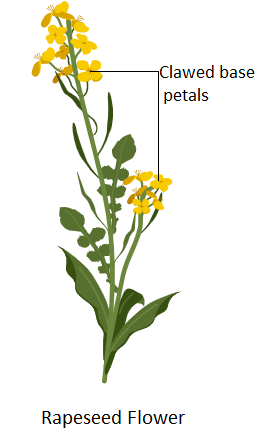
Claw is found in the petals of
A. Cruciferae
B. Fabaceae
C. Liliaceae
D. Solanaceae
Answer
471.9k+ views
Hint: The petals of different flowers have different variations. Some petals are round or some are pinned. The type of petals found in the flower tells a lot about the classification of the flower. In petals the lower part is usually thin or sharp, this is called a claw. Brassicaceae commonly including the mustard or cabbage family have claw-shaped petals.
Complete step by step answer: A flower is the reproductive part of a plant that contains both the sexual units of a plant. The flower consists of petals that are varied in shape, size, and color in different plants. The petals are the characteristics of the classification of plants. Usually, the petals are round or sharp ended. Some plants have flowers with petals having their bottoms being sharp and thin with a hairy appearance. This is seen majorly in the family of Brassicaceae or Cruciferae.
-The mustard family consists of herbs ranging from annual to perennial types. They lack stipules on their leaves that are arranged alternatively. The stems are composed of hairs having fork or star-shapes. 4 separate petals are contained in the calyx and the corolla separately.
-The petals are separable at the base into narrow claws having broader upper portions. The androecium consists of 6 stamens in a tetradynamous arrangement having 4 long stamens and 2 short stamens.
-On the other hand, the gynoecium is syncarpous and is made of 2 united carpels. The gynoecium contains the ovules that are borne along the ovary wall.
-The ovary partition goes across the carpels making a false partition. The fruit has a special name called silique or a silicle. It is short and squat and is strikingly modified. Thus, the Cruciferae are the ones that contain clawed petals.

Fabaceae, Solanaceae, and Liliaceae do not contain petals with thin bottoms and thus lack claw in petals.
Thus, the right answer is option A.
Note: The Brassicaceae family consists of cruciferous vegetables including broccoli, cabbage, cauliflower, turnip, radish, rapeseed, etc. these all contain claw in their petals.
Complete step by step answer: A flower is the reproductive part of a plant that contains both the sexual units of a plant. The flower consists of petals that are varied in shape, size, and color in different plants. The petals are the characteristics of the classification of plants. Usually, the petals are round or sharp ended. Some plants have flowers with petals having their bottoms being sharp and thin with a hairy appearance. This is seen majorly in the family of Brassicaceae or Cruciferae.
-The mustard family consists of herbs ranging from annual to perennial types. They lack stipules on their leaves that are arranged alternatively. The stems are composed of hairs having fork or star-shapes. 4 separate petals are contained in the calyx and the corolla separately.
-The petals are separable at the base into narrow claws having broader upper portions. The androecium consists of 6 stamens in a tetradynamous arrangement having 4 long stamens and 2 short stamens.
-On the other hand, the gynoecium is syncarpous and is made of 2 united carpels. The gynoecium contains the ovules that are borne along the ovary wall.
-The ovary partition goes across the carpels making a false partition. The fruit has a special name called silique or a silicle. It is short and squat and is strikingly modified. Thus, the Cruciferae are the ones that contain clawed petals.

Fabaceae, Solanaceae, and Liliaceae do not contain petals with thin bottoms and thus lack claw in petals.
Thus, the right answer is option A.
Note: The Brassicaceae family consists of cruciferous vegetables including broccoli, cabbage, cauliflower, turnip, radish, rapeseed, etc. these all contain claw in their petals.
Recently Updated Pages
Master Class 11 Economics: Engaging Questions & Answers for Success

Master Class 11 Business Studies: Engaging Questions & Answers for Success

Master Class 11 Accountancy: Engaging Questions & Answers for Success

Master Class 9 General Knowledge: Engaging Questions & Answers for Success

Master Class 9 English: Engaging Questions & Answers for Success

Master Class 9 Science: Engaging Questions & Answers for Success

Trending doubts
What are the elders in Goa nostalgic about class 11 social science CBSE

Define least count of vernier callipers How do you class 11 physics CBSE

Write the differences between monocot plants and dicot class 11 biology CBSE

Which of the following is not a feature of the election class 11 social science CBSE

The mass of oxalic acid crystals H2C2O42H2O required class 11 chemistry CBSE

How many squares are there in a chess board A 1296 class 11 maths CBSE




